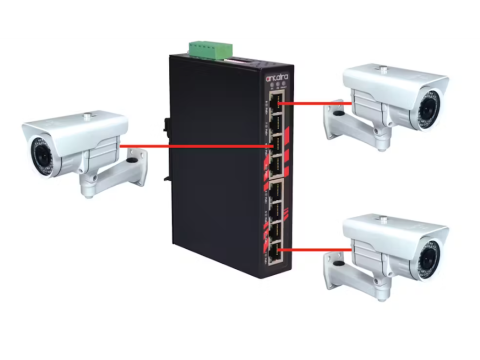SWITCH FOR VIDEO SURVEILLANCE
DEVICE AND CHARACTERISTICS
A network switch, or simply a switch, is a key element in IP video surveillance systems. Its primary function is to connect network nodes and facilitate data transmission between IP cameras and recorders.
Main Characteristics of a Switch:
Bandwidth
- Defines the volume of data the device can process per unit of time.
- Common values: 10/100 Mbps (Fast Ethernet) or 1 Gbps (Gigabit Ethernet).
- It’s crucial to consider that the combined bandwidth of all ports may exceed the switch's total capacity.
Number of Ports
- Determines the maximum number of cameras that can be connected.
- Small setups, such as home systems, often use switches with 4–8 ports. Professional systems require 16, 24, or more ports.
Design
- Indoor switches are suitable for environments with controlled conditions.
- Outdoor switches are built to withstand harsh weather and come with protection ratings, typically IP66 or higher.
PoE (Power over Ethernet)
- Allows power delivery and data transmission over a single Ethernet cable, simplifying installation.
- Ensure compatibility between PoE switches and cameras that support this function.
CHOOSING A SWITCH FOR VIDEO SURVEILLANCE
Factors to Consider:
Bandwidth and Packet Size
- Standard switches handle packets up to 1518 bytes, which aligns with the data stream from 2MP cameras.
- For higher-resolution cameras, ensure the switch supports larger packets to avoid freezing or signal loss.
Traffic Management
- A switch with insufficient capacity can lead to delays or distorted video streams.
PoE Capacity
- Check the power output per port (e.g., 15W, 25W) and total power capacity to ensure it can support all connected cameras.
- For high-power devices like PTZ cameras, consider switches with PoE+ or PoE++ standards (up to 90W).
Outdoor or Indoor Use
- Choose outdoor-rated switches for external installations; they provide weatherproof and robust designs.
Manufacturer Compatibility
- Switches from the same brand as the cameras often provide optimized performance and easier integration.
Recommendations for Use:
Home Systems:
- Budget-friendly solutions often suffice, and a home router can sometimes replace a dedicated switch for 1–2 cameras.
Professional Systems:
- Use purpose-built switches with robust specifications to handle high traffic and ensure system reliability.
- Pre-configured kits from reputable manufacturers can save time and ensure compatibility.
By carefully evaluating these factors, you can select a switch that meets the specific needs of your video surveillance system, ensuring stability, scalability, and efficiency.
Monitor for Video Surveillance Systems
08/01/2025

